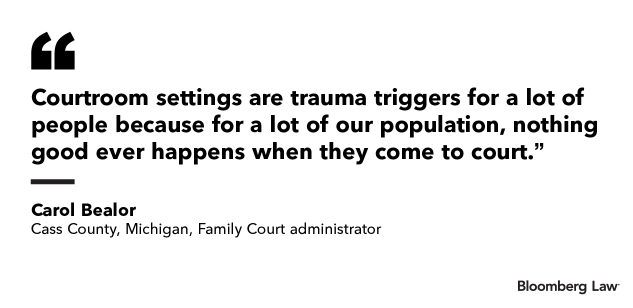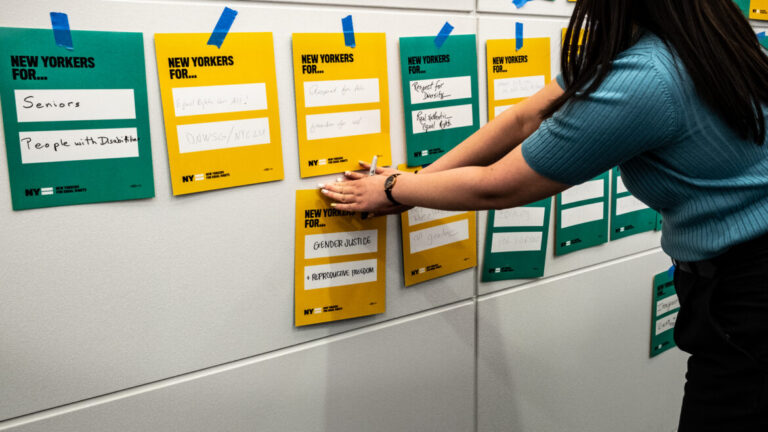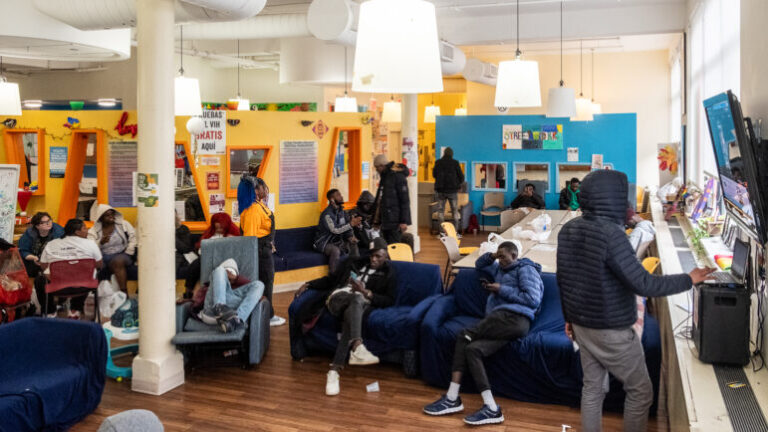By Allie Reed and Madison Alder
Bloomberg Law
The 8-year-old showed off her fancy braids, cowboy boots, and favorite stuffed animals over Zoom via an iPad in her grandmother’s home.
On the other end, Cass County, Mich., Family Court administrator Carol Bealor asked what she likes to do with her mom and her dad. Sing, the girl said. Proclaiming her love for the “Descendants” movie series, she lip-synced a song from the film while dancing and twirling atop a chair.
Slowly, Bealor worked up to why they were there: she had to ask the girl which parent she wanted to live with. With that warm-up, she spoke “with ease and confidence,” Bealor said. Even after 55 minutes, almost twice as long as those kinds of hearings with children usually take, the girl kept saying “wait a second” to show Bealor something else.
When Bealor finally hung up, she almost cried.
“It was just a different kind of interaction than we would’ve ever had in my office because the child was so comfortable in her environment,” Bealor said. The Zoom interview made her realize “all the harm we’ve done to kids having them come into our office,” just because “that’s the way we’ve always done things.”
For all the downsides of courts forced to go virtual during the coronavirus pandemic, judges, court staff and lawyers say they’ve discovered one surprise upside: technology can make the justice system—an institution designed to intimidate—much more accessible for children and domestic violence victims.
The pandemic “was not the disruption we wanted, but the disruption we needed,” said Bridget Mary McCormack, chief justice of the Michigan Supreme Court.
To be sure, remote proceedings remain a work in progress.
They’ve allowed children to participate from where they’re comfortable, rather than inside an imposing courtroom. They’ve spared domestic violence victims some of the stress of being in the same room as their abusers.
But they also raise concerns about how candidly children will speak if parties to a dispute are standing off camera, and about bringing harm to abuse victims who might unintentionally give on-screen clues about where they are.
If courts can address such concerns, remote technology “done properly” could well remain in place in family court after the pandemic is gone, said Amanda Beltz, director of the New York Legal Assistance Group’s domestic violence law unit.

Protection Orders
Before the pandemic, Leah Scondotto and her team at the Brooklyn Family Court Program of Safe Horizon, a victims’ advocacy group, would consult with people who came to the courthouse seeking help in family and domestic violence disputes.
The clients she worked with would often wait around the courthouse for hours—or an entire day—until their case got called. Now when Scondotto’s team gets a call seeking assistance in the morning, Safe Horizon files the petition electronically, the litigant appears before a judge by phone within roughly an hour, and the order of protection is emailed to them in 30 minutes to an hour, she said.
Remote hearings let judges observe dynamics they might never have seen in a courtroom.
When child welfare hearings were in-person, the first interaction between a child in foster care and their birth parents would take place in a lobby, outside a judge’s view. Over Zoom, judges and attorneys can see a child’s reaction to his or her parents in real time, said Josephine Vanderhorst, an attorney with Southeast Louisiana Legal Services.
Being able to observe that moment influences “the entire proceeding of the matter,” Vanderhorst said.
Children Zooming into court from their foster homes lets Vanderhorst see firsthand whether they’re comfortable.
Judges see more authentic responses from children and can read their facial expressions better, said Ashley Willcott, a juvenile court pro tem judge in Atlanta. “The intimidation factor goes away” and children’s increased comfort shows in their body language and answers, she said.
Avoiding Trauma
The courtroom experience—including a judge in a black robe seated above everyone as a way to project authority—can intimidate anyone, said Joan Meier, professor of law and director of George Washington University Law School’s National Family Violence Law Center.
That’s all the more true for children, and research suggests it can impact how they act in court. When their memory was tested, children questioned in a courtroom found it more stressful and made more mistakes than those interviewed in a familiar classroom, according to a 1993 UCLA study.
Children might think they’re in trouble for even being in court, or that they’ll be punished if they make a mistake. In cases where children are hurt, “the person who hurt them is sitting there in the courtroom, too,” said John Myers, a family law attorney and professor at University of the Pacific, McGeorge School of Law.
Going virtual allows victims of violence to avoid walking into a courtroom and having to see their abuser up close.
“Courtroom settings are trauma triggers for a lot of people because for a lot of our population, nothing good ever happens when they come to court,” Bealor said.
Just going through security and getting searched can make sexual-assault victims feel like they’re being assaulted again, said Susan Dobrich, a Cass County, Mich., probate judge.
“Victims of abuse are already traumatized by an abuse of power. That’s essentially what abuse is,” Meier said.
Tech Issues
Virtual courts can also pose challenges for marginalized groups, lawyers say.
Tracy Davis, managing attorney for Bread for the City, a Washington-based group that serves low-income clients, said remote proceedings have been more challenging than helpful to people without high-speed internet or phone connections.
“It doesn’t feel like access to justice in terms of their full ability to participate in the hearing,” Davis said. And when they do have access to video, there are privacy and safety questions, she said.
An abuser might be able to figure out where victims are, based on the background in their video, Davis said. What judges see in litigants’ homes could also cause unconscious bias. “We already have judges who make comments about what our clients are wearing,” she said.
Judges also can’t tell in remote hearings whether someone else is in a room where a child is testifying. “Are they directing the testimony? Are they shaking their head yes or no? Are they holding up notes? Are they telling that person what to say?” Willcott, the juvenile court pro tem judge, said.
In domestic violence cases, Beltz, the New York Legal Assistance Group lawyer, said she’s run into requests from the court that litigants not have their children present during the virtual proceeding. That’s “just not reflective of the reality of how people are living” during the pandemic, she said.

Future Use
How remote proceedings are implemented after the virus no longer poses a threat could vary by jurisdiction.
Michigan assembled a task force to study lessons learned from the pandemic, and is seizing the chance to adapt courtroom technology for a “21st century justice system that is accessible, effective, transparent, efficient, and fair,” McCormack, the state’s chief justice, said at a June House Judiciary subcommittee hearing.
“Now that the genie is out of the bottle, it’s not going back in,” McCormack said.
Family courts in New York are discussing making the virtual technology available to litigants seeking protection orders after the pandemic, said Scondotto, the Safe Horizon director in Brooklyn.
If the courts work to improve the access and privacy issues, Beltz said she could see the benefits of attorneys not having to be in court all day.
“We would be able to help more people if the system were more efficient,” Beltz said.
Originally published in Bloomberg Law on July 23, 2020.








